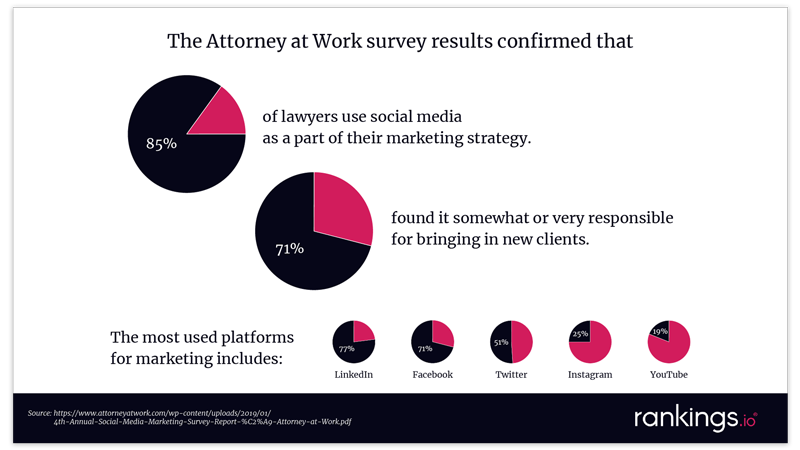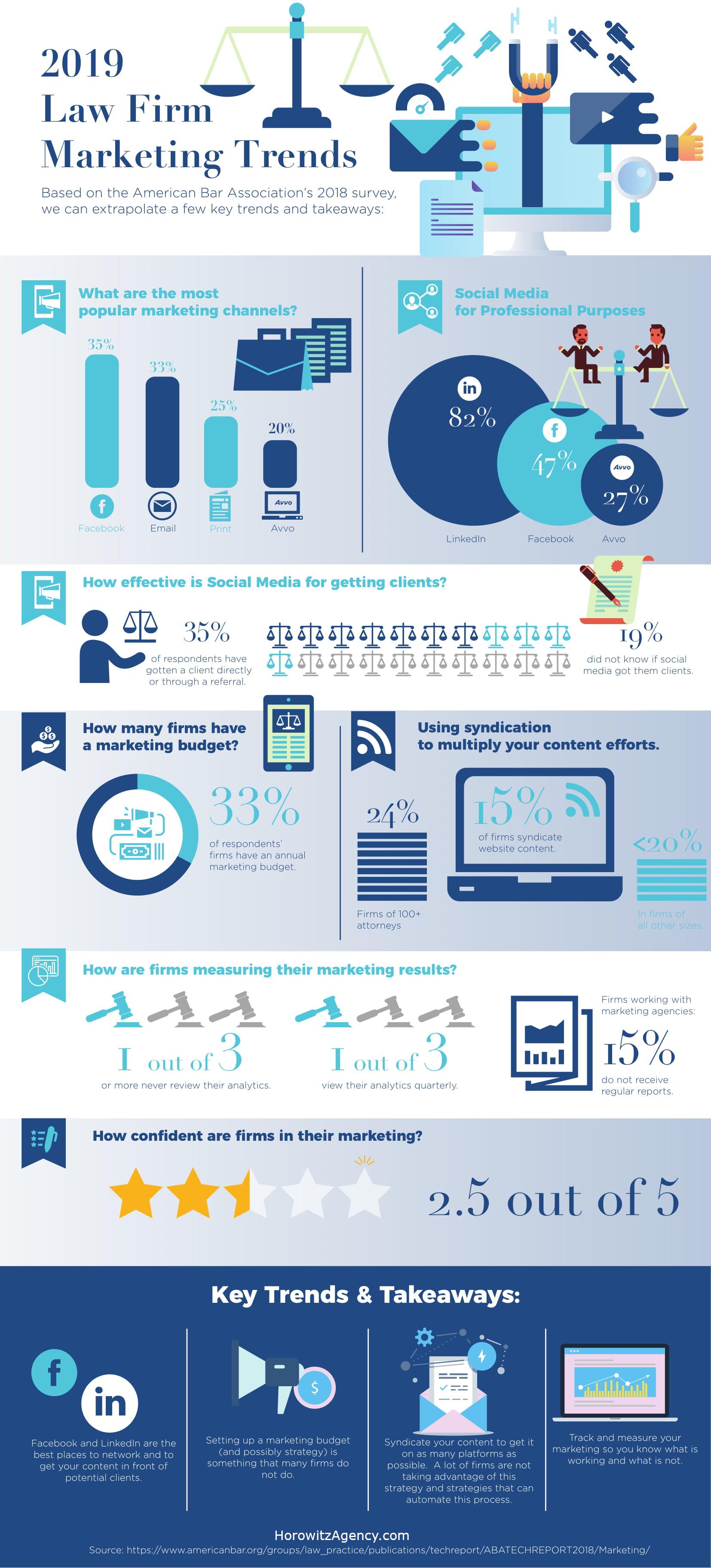The complete guide to social media for law firms

Table of contents
Lawyers have always used the full spectrum of advertising media. They put up eye-catching billboards, make memorable local TV commercials, and smile at us from the backs of bus stop benches. Nevertheless, social media advertising is still terra incognita for many law practices.
Law practice and social media marketing are an odd marriage, and it’s not always an easy fit on either side. For marketers, dealing with regulatory hurdles and mandatory legalese sounds like a nightmare. For law firms, the idea of showing up on the same feed alongside cat photos and viral videos may lack a certain gravitas. How can this gap be bridged, and why is it worth your attention?
4 reasons law firms should use social media
The fact is that traditional advertising can still get attention in the right places. But what are those places today? Nobody drives around looking for a law firm billboard when they’re in need of legal representation. When people shop around, whether for a new phone or a new attorney, they’re online. Online today means on social media.
The numbers support the argument: 31% of law practices with a professional social media presence report having acquired at least one new client through it. However, less than half of all small to midsize law practices advertise or try to acquire new clients through social media. That means many markets are potentially wide open for practices to stand out and get noticed. All it takes is some creativity and the right set of tools.

There are four key marketing elements that a strong social marketing strategy can provide:
1. SEO
Social media shares and other activities related to your posts and videos can help boost your practice’s search engine rankings. Consistently publishing quality content is a much more effective way to optimize your search engine ranks and reach than trying to outsmart ever-changing algorithms.
2. Engaging target audiences
Passive advertising depends on your audience being in the right place at the right time to see your message and be receptive to it. When you’re marketing over social media, you have much greater control over these variables. You can isolate a specific audience segment that’s relevant to your area of practice and target them with tailored messaging.
3. Generating leads
Ultimately, this is what any marketing endeavor is all about—drumming up new business. With a receptive audience in your social media pocket, you’ll get inquiries that become opportunities to offer consultation appointments. Moreover, you can identify leads who clearly need your services but just need a little marketing nudge to get them to make initial contact.
4. Establishing thought leadership
Thought leadership can be a fantastic opportunity for lawyers who often specialize in interesting areas of law and have a gift for expressing themselves in compelling and persuasive ways. When can you deliver expert insights in a way that appeals to your audience? You can build an organic following that raises your profile and generates positive word-of-mouth.
What makes law practice social media different
One of the most intimidating things about social media marketing for law practices is navigating the relationship between the laws and regulations that uniquely apply to businesses engaged in practicing law and the inherently chaotic nature of social media. On closer inspection, however, these differences are not that scary, and the pitfalls are easy enough to avoid.
The ABA has created guidelines for lawyers’ ethical use of social media. This set of guidelines covers topics like confidentiality over social media, discussing hypothetical or anonymized cases online, and engaging in actions that suggest a conflict of interest (for example, lawyers are told not to friend judges or slide into their DMs). It also specifically addresses advertising and soliciting clients over social media.
Essentially, the ABA considers any communication to a potential client that discusses the lawyer’s service should be considered advertising and would be subject to ABA Rule 7.3: Solicitation of Clients.
Just keep in mind that the ABA’s guidelines are only guidelines, and you’ll still have to review the rules of your state bar association to ensure your marketing activities comply. The ABA guidelines, however, should give you a good sense of the boundaries you’ll need to stay within.

Recommended for further reading
10 tips for law practices using social media
1. Choose your niche
Some law practices serve businesses or upscale clients to whom money is no object; others fight for the little guy. There are all kinds of market niches for lawyers and law firms. To craft your messaging effectively, you have to know—or decide—which one you’re in.
2. Understand your audience
Do your clients tend to favor lengthy representation with lots of consultations or are they just looking for help getting a few things filed quickly? Are they likely to appreciate humorous messaging, or is dead-serious professionalism the approach they prefer? Ask yourself all these questions and others to build your buyer personas.
3. Select the social media platforms relevant to your niche and audience
People tend to use different social media platforms for different reasons, and your relevant audience segments might not be well-represented on every platform. LinkedIn is probably the first place to plant your marketing flag if you’re a corporate law firm. You might get better results with Facebook or Quora if you’re a divorce attorney.
4. Employ social listening
There’s no better time to make your presence seen on social media than when people are talking about your brand or your area of specialty. Social listening tools are your ears on the ground when conversations that concern you are happening on social media. These tools can be especially helpful at drawing your attention to problems or controversies that haven’t quite yet broken into mainstream conversation.
5. Develop a content strategy
Of course, social media marketing isn’t about flooding the zone with whatever’s on your mind whenever you feel like posting. To build an audience and keep them coming back, you must post quality content consistently. Your strategy needs to dictate what content media types to use, how often to publish on social media, and how to measure the results. This way , you can adapt and swap out content that doesn’t resonate with your audience.
6. Get your employees aboard with employee advocacy
Audiences are willing to engage with brands with the right approach, but there’s still no substitute for a person-to-person connection. When employees at your practice share links and post about your practice, they can potentially reach far more people than when you post from an official company account. The right employee advocacy strategy can also feel more genuine and engaging to many potential clients.
7. Share insightful and relevant content (without being too controversial)
Sharing content and insights on the interesting, relevant topics of the day can be a great way to build familiarity with your audience without coming across as aggressively marketing your services. The danger is that you might alienate some leads by coming across as opinionated or biased in your choice of topics. Knowing your target audience and buyer personas well can make a huge difference and help you avoid any PR disasters.
8. Humanize your brand and tell your story
The average person doesn’t necessarily find law firms friendly and approachable. Social media can be an excellent platform for letting the lawyers in your practice show their human side and tell the story of your firm’s history and accomplishments.
9. Respond and engage with your audience
Social media is reciprocal in nature. If you want leads to engage with your content and generate activity on your feeds, you’re going to have to put yourself out there and engage with them. This is especially true when they make the effort to ask a question or participate in a discussion. People go on social media to feel seen and acknowledged—be generous with your likes and responses.
10. Experiment with content formats and be an early adopter of social media innovations
Public digital platforms are always inventing and testing new ways to deliver content and get people clicking. When something new and innovative gets rolled out to business accounts? It’s the perfect time to jump in and take advantage of the fact that the novelty will get people’s attention.
The full potential of social media marketing for law practice has yet to be realized. This means there’s plenty of room for creative and adventurous firms to stand out from the crowd and carve out a following.
It’s true that lawyers have some additional rules and guidelines to follow when they’re marketing on these platforms, but that’s no reason to shy away. On the contrary—lawyers have an easier time than most dealing with rules and limitations.
If you know your audience and develop a robust content strategy based on strong, effective methods? You can build a social media presence that will give your reputation a boost and bring in new leads and clients from all corners.




